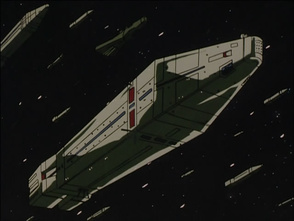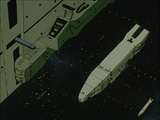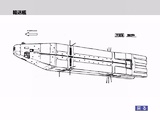Alliance transport (788 UC era)
From Gineipaedia, the Legend of Galactic Heroes wiki
 Alliance transport (796 UC (487 IC / 3596 CE)) | |
| Affiliation: | Iserlohn Republic El Facil Revolutionary Government Free Planets Alliance |
| Type: | Transport |
| Length: | 2480 metres(FFC1) |
| Width: | 463 metres(FFC1) |
| Height: | 494 metres(FFC1) |
| Armament: | 16 frontal beam cannons (FFC1) |
| Crew: | 26 (FFC1) |
This Alliance transport (Japanese: 輸送艦) design served as the standard transport design of Alliance fleets from the late stages of the Alliance–Imperial War to at least 801 UC (3 NIC / 492 IC / 3601 CE) under the successor states of the El Facil Revolutionary Government and Iserlohn Republic.
Contents |
Design
The standard Alliance transport was essentially rectangular in shape with a wedge prow, and 4 engines in the rear.
For self defence, 16 beam cannons were mounted in the prow.
Role and Capabilities
It served as the main Alliance military transport design, capable of transporting a wide variety of cargo types, including food, ammunition, and energy. It was critical to the effectiveness of fleets far from their supply lines, and the destruction of the Alliance transport fleet under Admiral Scott in 796 UC (487 IC / 3596 CE) was instrumental in bringing about the devastating defeat of the Alliance invasion fleet at the hands of Reinhard von Lohengramm. (LOGH: 'The Battle of Amritsar Starzone', 'The Battle of the Corridor: End of the Campaign')
Alliance warships were capable of docking alongside it for direct resupply.
Gallery
Resupplying docked battleships (800 UC (2 NIC / 491 IC / 3600 CE)) |
Appendices
Licensed sources
These ships formed the vital link between the Alliance's rear supply bases and the front lines. They were commonly organised into squadrons of tens of transports each. Normally when moving in convoy, each transport would maintain a distance of 0.1 to 0.2 light seconds from each other, and link their sensors together via FTL communication links, creating a large virtual sensor array to keep watch for danger.
The bridge and crew quarters were located in the front section, and the engineering section at the rear. Aside from the captain, there were 6 navigational crew, 6 engineering crew. Communications, security, and logistics crew added up to another 12.
The 16 cannons mounted were purely for self defence. As the ship's sensors lacked high resolution capacity for long range targeting, and as the transport was not meant for combat, it was decided to fit small calibre, low power, rapid firing beam cannons.
The transport's cargo compartment measured 1,100 metres by 360 metres by 360 metres. The total effective cargo capacity was 135.4 million cubic metres. Using the standard of liquid hydrogen at its boiling point, the transport could carry 9,600 tons (rounded up to the nearest hundred tons). In the middle of the compartment was a connecting structure between the forward crew sections and the engineering section at the rear. It contained power conduits and communication lines as well as passageways for movement of crew. Normally the cargo compartment was not pressurised and was a vacuum. Any cargo requiring atmosphere or temperature control had to be carried in airtight containers.
In the past, personnel were transported in a cold sleep state in airtight containers but this practice was discontinued due to criticism of this as a violation of human rights.
The transport's size led to it being considered as a possible delivery system for high yield strategic planetary scale missiles, but the low mobility of the ship led to this idea being discarded.
One variant design that did come to fruition was the hospital ship variant. Modification of the cargo compartment and installation of medical facilities created a hospital ship with capabilities matching that of a large scale hospital on Heinessen. Of the hospital ships assigned to Alliance fleets, over half were converted transports. Naturally such hospital ships were completely unarmed, with the front 16 cannons removed, though the old cannon gun ports remained visible.
The engines were designed for fuel efficiency to reduce fuel consumption rather than for high thrust. When the transports had to accompany the main fleet, their fusion reactors were operated at a higher internal pressure and an additional fuel propellant tank was added in the cargo compartment. Modular construction was used for the engines, which raised ship readiness rates. The entire engine could be swapped out for a fresh one, and supply bases carried on average about 10 such units. The modular design meant there was one example of a large battleship engine being fitted but the ship's structure could not safely withstand the high thrust.
Apocrypha
DVD features
A sketch of the Alliance transport appear in the extra features of the DVD box set.

